
Newsletter
Newsletter
This week, we look at how publishers are balancing paid content and advertising strategies and how product thinking can make your publication indispensable.
28th September 2022

In the Pugpig weekly media bulletin, Pugpig’s consulting services director Kevin Anderson distills some of the best strategies and tactics that are driving growth in audiences, revenue and innovation at media businesses around the world.
It has been more than a decade since Jim Brady, now of the Knight Foundation, gave me this nugget of wisdom about digital media businesses: “There are no silver bullets, only shrapnel.” What he meant was that there was not going to be any one thing that builds a sustainable media business. It would require diversity in editorial products and revenue streams. Building on that, Chris Krewson, the executive director of the Local Independent Online News Publishers group in the US, recently told Pugpig that his group tries to encourage their members to have at least three revenue streams. It’s a good reminder that a balanced approach for your publication or your group will provide you with the best chance of success.
Sign up to get the Media Bulletin in your inbox.
Last week, at the Press Gazette’s Future of Media Technology conference, News UK Chief Operating Officer David Dinsmore provided an example of that as he discussed balancing paywalls and advertising, both in terms of within properties and also across the company’s portfolio, according to Esther Kezia Thorpe at What’s New in Publishing.
“I don’t think it’s paywalls versus advertising. I think it’s paywalls and advertising, and both are an outcome of consumer engagement.” Dinsmore said during a panel discussion. And more than simply working to optimise both revenue streams, he also pointed out that the approach varies based on the properties in their portfolio. The approach for the “cash-rich, time-poor” audiences of The Times is different than that at The Sun. But it is not a binary approach of a paywall for one property with all free, ad-supported content at the other. Dinsmore sees great opportunities in niche paid offerings at the Sun like bingo. Paywalls and registration walls also add richness to the data known about users, which can help support better ad targeting and better results for advertisers.
As Dinsmore points out, digital audiences are growing, and to keep them growing, publishers also need to balance activities at different parts of their conversion funnel. One of the most effective ways of attracting new users has been through search, and paywalls can present some challenges when it comes to SEO. Publishers will want to make sure that they have the right paid content and SEO strategies based on the type of paid content they have, says French membership and subscription service provider Poool. Of course this involves keeping on top of the latest changes at Google particularly around the structured data that you provide, but Poool also dives deeply in their report about how different paid content strategies – hard, freemium, hybrid or dynamic – should inform your SEO strategy.
Also depending on your content mix, Poool provides a decision-making process to inform your choices around what is free, free for a time or a certain audience and what is premium content only for paying customers. Again, it’s about balance, keeping your most exclusive content for paying customers but also providing a way to highlight that content to non-paying customers. One of my favourite features that the New York Times and Financial Times provide is the ability for subscribers to share stories with non-subscribers. This is all to say that the old paid versus free debate has shifted to a more complex set of strategic decisions to build a sustainable digital media business.
Last week, we talked about how major publishers are trying to rebuild and remix their subscription bundles to maximise revenues. Building a wide range of subscription content products across the broad range of traditional news topics makes sense for major international publishers like the New York Times who have the resources and scale and have built major subscriber bases. However, Brian Morrissey, the former editor-in-chief of Digiday, highlights another set of strategies pursued by focused content businesses. Instead of bundling wide swathes of content and subscription products, other publishers are diving deep into niches, especially lucrative niches. Many of these publishers have either had lucrative exits or investments. He highlights Industry Dive, which was recently acquired by Informa for $525m and Recurrent, which recently received a $300m investment from Blackstone so the group could continue its acquisitions in the lifestyle space.
Morrissey contrasts the success that these niche publishers are experiencing with the digital publishers of a decade or more ago. Just think of the challenges that Buzzfeed is facing. Many of the previous digital media start-ups had aspirations of being this generation’s media empires, sprawling properties or groups of properties that try to attract mass audiences with a wide but relatively thin range of content.
Morrissey is right that it takes humility to launch a property that isn’t trying to “be all things to all people”. Rather as Axios CEO Jim VanderHei recently said in an interview with Puck, these new publishers are “proudly narrow in their focus”. That doesn’t mean that these niche publishers lack ambition or lack the ability to scale. “(S)tack enough niches and you can get big, just as Axios and Industry Dive,” Morrissey says.
The cutting edge of media thinking has evolved from digital-first to audience-first and now to a broader product focus. Paul O’Mahony, editorial product manager at The Local Sweden, describes product thinking as working to “make sure that the publication is useful to its readers”, according to Marcela Kunova at journalism.co.uk. People buy products he says because they solve a problem in their lives.
Product thinking has helped The Local understand what problems people want to solve and what they find valuable. In product parlance, they are working to find a market fit. Of course they tap their user data. Analytics can help you understand what people find valuable, but qualitative data – interviews with users or surveys – can help you understand why they find that content valuable. Product thinking is an iterative process with data and user feedback providing direction on how to make their products even more useful to their audiences. The Local runs user surveys and tweaks its products, whether that is a feature, a podcast or a newsletter.
And the results of this approach speak for themselves, The Local has grown its subscriptions from 15,000 to 50,000 in the last two years. And more than that, O’Mahoney said that he recently received an email from a reader. Due to the rising cost of living, they were rethinking their subscriptions. The reader was going to cancel Netflix but not The Local because it “was their most important subscription”. It shows how product thinking to make their publication useful has made them indispensable.
Here are some of the most important headlines about the business of news and publishing as well as strategies and tactics in product management, analytics and audience engagement.

Newsletter

Newsletter

Newsletter

Newsletter

Newsletter